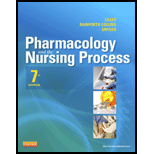
To discuss:
The importance of immunity as it relates to the various immunizing drugs and their use in patients of all the ages.
Concept introduction:
The immunology is a branch of science that studies and deals with the immune system of the body. The immune system helps to protect against the invading pathogens as well as to eliminate whatever that are regarded as foreign to the body.
Explanation of Solution
Though the body has the ability to adapt to various antigens and proteins of different pathogens, allergen, and venom, it needs time to respond and produce new antibodies against it. During the time of antibody adaptation, the invading foreign things take over the host system and can cause devastating damage. Hence, the immunizing drugs come into play to take the role of the antibodies and effectively eliminate the foreign allergens. The immunizing drugs come in different variations such as active immunization, antiserum, immunoglobulin, passive immunization, and the booster dose.
Active immunization: The active immunization is also known to be vaccines that are available as attenuated, live, or killed.
Booster dose: The booster dose is given to reactivate the immune memory when the antibodies have not encountered the antigens for a long time.
Passive immunization: The passive immunization has specific antibodies that are produced against the specific antigens. Immunoglobulin, antiserum, antivenin, and antitoxin are all the types of passive immunization.
The active immunization is given to infants to protect them from MMR, polio, HBV, influenza, and tuberculosis. The passive and booster dose are given to all ages and people with allergies are given recombinant immunization drugs.
Want to see more full solutions like this?
- Discuss the current antenatal care approach for pregnant women and provide the highlight of activities conducted during woman’s antenatal visit, clearly describing the steps needed for successful antenatal care.arrow_forwardDefine obstetric emergencies and state and briefly explain any two (2) maternal, foetal, and obstetric complications that require immediate intervention.arrow_forwardExplain how mental health services can be effectively integrated into maternal and child health, visa-viz early childhood development.arrow_forward
- Enumerate any four (4) potential complications during puerperium and highlight key measures to manage these complications.arrow_forwardDescribe the physiology of the first stage of labour.arrow_forward58. Consider the circuit shown below. Find 11, 12, and I3 when (a) the switch S is first closed, (b) after the currents have reached steady-state values, and (c) at the instant the switch is reopened (after being closed for a long time). 1 R1 ww 13 12 E S 0000 ww R2arrow_forward
- Regularity- Rate- P waves- PRI- QRS- Interpretation- Normal sinus rhythm, sinus bradycardia, sinus tachycardia, sinus arrhythmia, sinus pause, sinus arrest, normal sinus with PACs, atrial fibrillation, atrial flutter, multifocal atrial tachycardia, wandering atrial pacemaker, supraventricular tachycardia, junctional rhythm, accelerated junctional rhythm, junctional tachycardia, premature junctional complex, premature ventricular complex, ventricular tachycardia, ventricular fibrillation, idioventricular rhythm, accelerated idioventricular rhythm, asystole, first-degree AV block, second-degree AV block type I (Wenckebach), second-degree AV block type II (Mobitz II), third-degree AV block (complete heart block), bigeminy, trigeminy, quadrigeminy, couplet,somatic tremor,AC interference,wandering baseline and etc (answer correctly using the 5 step method and only use those terms above)arrow_forward76. 80. 81. 82. 83. 33arrow_forward69. 70. 71. 72. 73. 74.arrow_forward
- 63. 64. 65. Rhythm: P wave: QRS Complex: Rate: PRI: Interpretation: Rhythm: P wave: QRS Complex: 66. 67. 68. Rhythm: P wave: QRS Complex: Rhythm: P wave: QRS Complex: Rate: PRI: Interpretation: Rate: PRI: Interpretation: Rate: PRI: Interpretation:arrow_forward59. 57. 60. 62. 55. سلسلہ ་་་་arrow_forward• Define the first stage of labour. • Describe the physiology of the first stage of labour. • Enumerate any four (4) potential complications during puerperium and highlight key measures to manage these complications.arrow_forward
 Phlebotomy EssentialsNursingISBN:9781451194524Author:Ruth McCall, Cathee M. Tankersley MT(ASCP)Publisher:JONES+BARTLETT PUBLISHERS, INC.
Phlebotomy EssentialsNursingISBN:9781451194524Author:Ruth McCall, Cathee M. Tankersley MT(ASCP)Publisher:JONES+BARTLETT PUBLISHERS, INC. Gould's Pathophysiology for the Health Profession...NursingISBN:9780323414425Author:Robert J Hubert BSPublisher:Saunders
Gould's Pathophysiology for the Health Profession...NursingISBN:9780323414425Author:Robert J Hubert BSPublisher:Saunders Fundamentals Of NursingNursingISBN:9781496362179Author:Taylor, Carol (carol R.), LYNN, Pamela (pamela Barbara), Bartlett, Jennifer L.Publisher:Wolters Kluwer,
Fundamentals Of NursingNursingISBN:9781496362179Author:Taylor, Carol (carol R.), LYNN, Pamela (pamela Barbara), Bartlett, Jennifer L.Publisher:Wolters Kluwer, Fundamentals of Nursing, 9eNursingISBN:9780323327404Author:Patricia A. Potter RN MSN PhD FAAN, Anne Griffin Perry RN EdD FAAN, Patricia Stockert RN BSN MS PhD, Amy Hall RN BSN MS PhD CNEPublisher:Elsevier Science
Fundamentals of Nursing, 9eNursingISBN:9780323327404Author:Patricia A. Potter RN MSN PhD FAAN, Anne Griffin Perry RN EdD FAAN, Patricia Stockert RN BSN MS PhD, Amy Hall RN BSN MS PhD CNEPublisher:Elsevier Science Study Guide for Gould's Pathophysiology for the H...NursingISBN:9780323414142Author:Hubert BS, Robert J; VanMeter PhD, Karin C.Publisher:Saunders
Study Guide for Gould's Pathophysiology for the H...NursingISBN:9780323414142Author:Hubert BS, Robert J; VanMeter PhD, Karin C.Publisher:Saunders Issues and Ethics in the Helping Professions (Min...NursingISBN:9781337406291Author:Gerald Corey, Marianne Schneider Corey, Cindy CoreyPublisher:Cengage Learning
Issues and Ethics in the Helping Professions (Min...NursingISBN:9781337406291Author:Gerald Corey, Marianne Schneider Corey, Cindy CoreyPublisher:Cengage Learning





